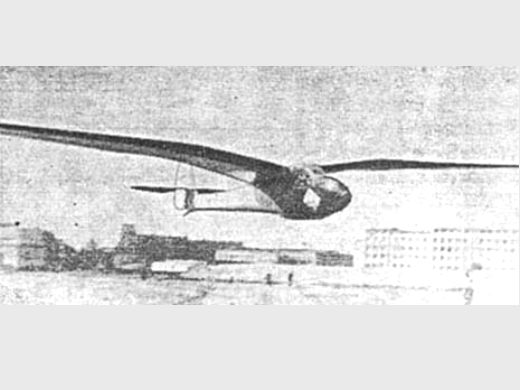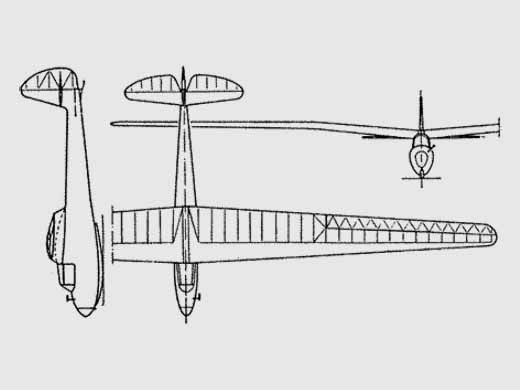
Grzeszczyk SG-7
| DONNÉES GÉNÉRALES |
| Année du premier vol (ou de design, si seul projet) |
1937 |
| Pays | Pologne |
| Designer(s) | GRZESZCZYK, Szczepan |
| Premier constructeur | Warsztaty Szybowcowe (PO) |
| Type d'appareil | Planeur |
| Fonction | Performance |
| SPÉCIFICATIONS TECHNIQUES |
| Envergure | 15.8 m |
| Longueur | 6.3 m |
| Hauteur | 1.65 m |
| Allongement | 15.7 |
| Surface alaire | 15.9 m2 |
| Profil aile | -- |
| Masse à vide | 160 kg |
| Masse maxi | 243 kg |
| Charge alaire | 15.3 kg/m2 |
| Vitesse mini | 50 km/h |
| Vitesse maxi | 200 km/h |
| Finesse maxi | 22 à 66 km/h |
| Taux de chute mini | 0.72 m/s à 58 km/h |
| Nb sièges | 1 |
| Structure | Bois et toile |
AUTRES INFORMATIONS
| Constructeur(s) |
| ||||||
| Infos techniques | Monoplan à ailes cantilever directement fixées sur le fuselage et non sur une cabane, contrairement aux précédents planeurs SG. | ||||||
| Histoire résumée | À la demande du ministère des Communications polonais, Stephen Grzeszczyk conçu le planeur SG-7 planeur pour participer au Concours International de la Rhön-Wasserkuppe. Deux prototypes du planeur ont été construits dans les ateliers d'Anthony Kocjan. Le premier SG-7 vola à la fin du printemps de 1937, aux mains de Grzeszczyk. A la suite d'essais comparatifs avec l'Orlik et le PWS 101, qui ne donnèrent pas les résultats escomptés, la production en série ne fut pas lancée. L'un des prototypes, portant l'inscription «Soyez prêts» sous les ailes, piloté par Stefan Waciórskiego, a participé au Rallye International Scout Vogelenzang aux Pays-Bas (du 29.07 au 19.08.1937). Avec le seconde SG-7 Modlibowska Wanda V. a participé aux Championnats nationaux de Vol à voile à Inowrocławiu (5-15.08.1937). Les deux planeurs ont été utilisés jusqu'à l'éclatement de la guerre à des fins de formation. A l'automne 1939, il avait été envisagé de modifier les deux prototypes de SG-7 pour les améliorer (version SG-7bis), dans les ateliers de Vol à Voile de Silésie [Śląskich Warsztatach Szybowcowych] à Bielsko. The SG-7 high-performance sailplane, conceived by Szczepan Grzeszczyk in 1936, was a progressive development of the SG-3 series of sailplanes. Two SG-7 airframes were built to a Ministry of Transport order by Warsztaty Szybowcowe (Glider Workshops) and registered SP-860 and SP-863 began flight trials in the spring of 1937, but as far as is known no further examples were made. The SP-860 went to the Netherlands at the end of July with the Polish Scouts' contingent for the 1937 (Fifth) Jamboree, whilst the SP-863 appeared at the Fifth National Glider Contest at Inowroclaw, which began on August 5. The SG-7 was contemporary with the Orlik and the P.W.S.101, and, compared with them, made better use of lower speeds and was designed for greater stick forces to permit smoother flights in turbulent conditions and in cloud, but its overall performance and maneuverability were rather inferior. As the design did not meet in full the new structural demands for cloud flying which came into force in Poland in 1938, the SG-7 was to be modified to the required standard by S.W.S. (Slaskie Warsztaty Szybowcowe, Silesian Gliding Workshops) of Bielsko, and a new development, the SG-7bis, was being built in 1939. The outbreak of war prevented completion of this work. The war also cut short the construction of the SG-8 powered glider prototype, the last of Grzeszczyk's designs. | ||||||
| Liens personnalités | GRZESZCZYK, Szczepan (Pologne) |
SOURCES DOCUMENTAIRES
| Liens WEB | Site : Site de Piotr Piechowski . Note + 1 photo + plan 3 vues + specs [Lien mort]. (2009-11-04 CL) Site : Samoloty w Lotnictwie Polskim . Texte + photo + specs. (2020-04-09 CL) Site : 1000 Aircraft Photos [Nico Braas Collection] . Texte + photo + specs. (2020-04-09 CL) |
| Livres | Antoni Kocjan : szybowce i walka z bronią V par GLASS, Andrzej (2002) [p. 188-189. Note + photo + plan 3 vues + specs]. Polskie konstrukcje lotnicze, Tom III par GLASS, Andrzej (2008) [p. 276. ]. |

Team J2mcL © 2003 -
- Pages optimisées pour Mozilla Firefox

